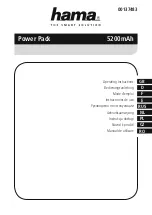
QUINT4-PS/1AC/24DC/10
107100_en_01
PHOENIX CONTACT
33 / 50
13
SFB technology
SFB
Technology (selective fuse breaking) can be used to
quickly and reliably trip miniature circuit breakers and fuses
connected on the secondary side. In the event of a short
circuit on the secondary side, the power supply supplies up
to 6 times the nominal current for 15
ms. The faulty current
path is switched off selectively.
Loads that are connected in parallel are still supplied with
energy. Operation of these system parts is ensured. In order
to always enable the reliable tripping of circuit breakers and
fuses, certain framework conditions must be observed (see
SFB configuration section).
13.1
Tripping circuit breakers
The circuit breaker is tripped by the high SFB current of the
power supply, typically within 3 to 5
ms. As a result, voltage
dips at loads that are connected in parallel are avoided.
Figure 30
SFB pulse trips circuit breakers
13.2
Tripping a fuse
Fuses are tripped by melting the predetermined breaking
point inside the fuse capsule. The tripping characteristic of
the fuse is described by the melting integral (I²t). A high
current is crucial in order to achieve a very short tripping
time.
13.3
SFB configuration
Observe the following framework conditions for determining
the maximum distance between the power supply and load:
–
The performance class of the power supply
–
The cross section of the connecting cable
–
The tripping characteristic of the fuse component
Figure 31
Schematic diagram of the maximum cable
length
The U/I
Advanced output characteristic curve
supports SFB
technology.
6x I
N
I
N
typ. 3 - 5 ms
0
I [A]
t [s]
-
+
-
+
l
Load
Power supply unit
















































